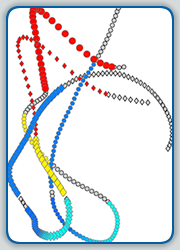Events such as the avoidance manoeuvres in a moving animal group, the capture of a prey or food item, the transmission of an infectious disease from an infected to a susceptible individual, or molecules escaping from narrow openings of a cellular membrane, are all examples of processes whose occurrence can be understood by quantifying the underlying spatio-temporal dynamics of the agents or entities involved. Modelling these processes consists of representing the movement of an individual and the interactions among them.
Our aim is to identify the local mechanisms of interaction between the individuals, model and predict the patterns they generate and compare the theoretical outcomes to the rare, and generally coarser, experimental observations. This complexity approach relies upon a combination of modelling and data analysis and allows us to address ubiquitous questions in research areas across disciplines and scales, ranging from animal ecology and behaviour to cellular and molecular medicine.
